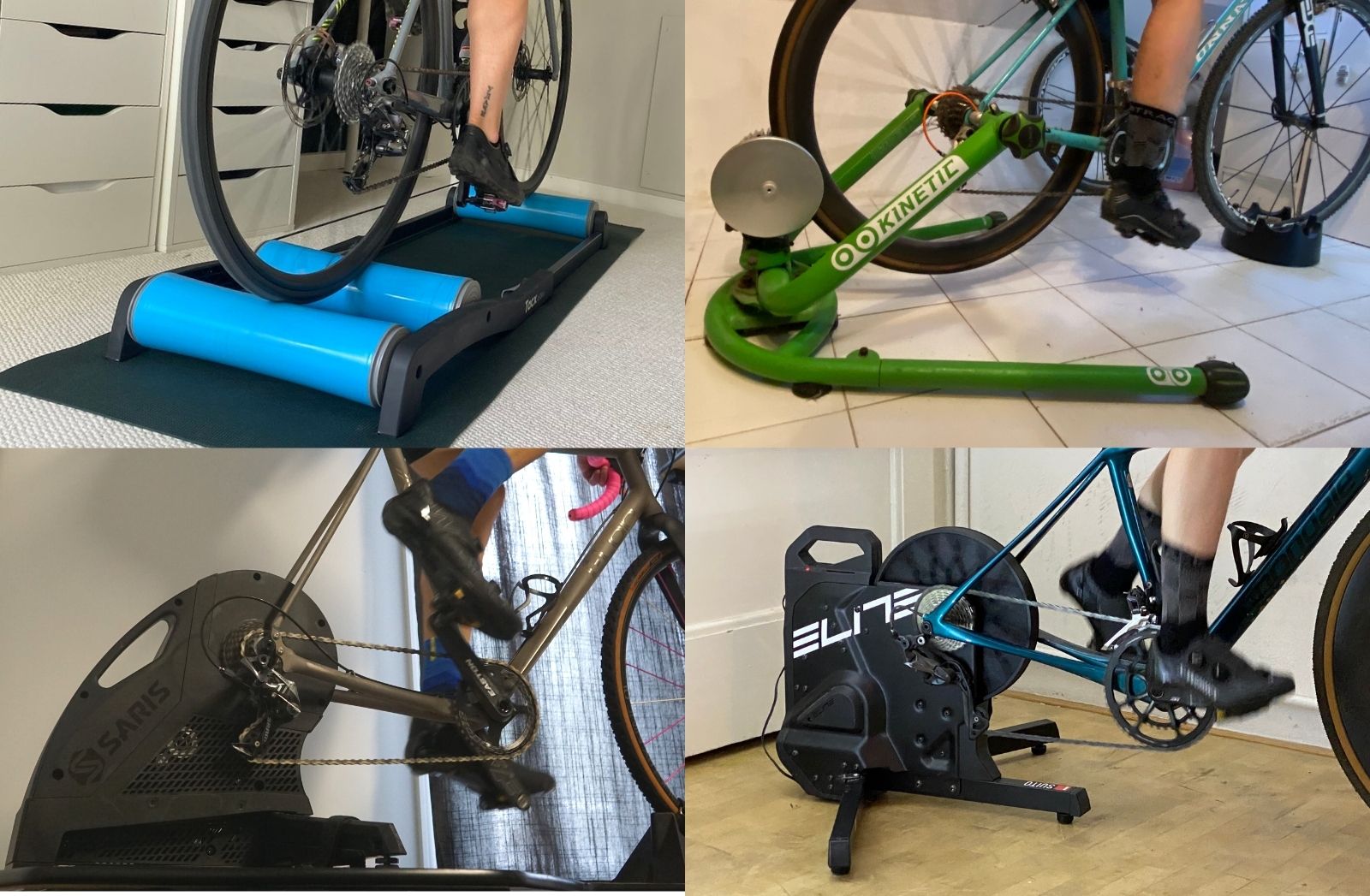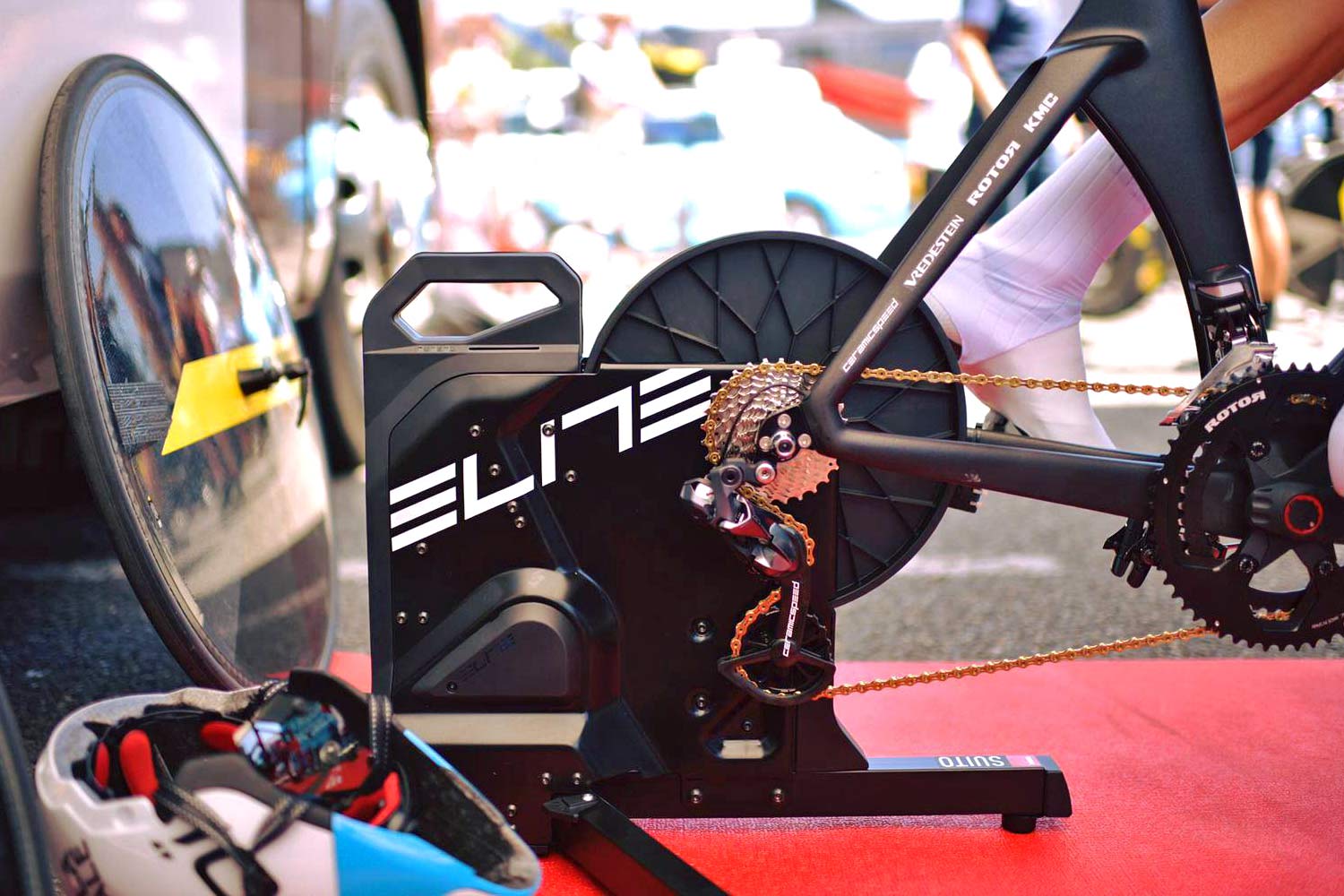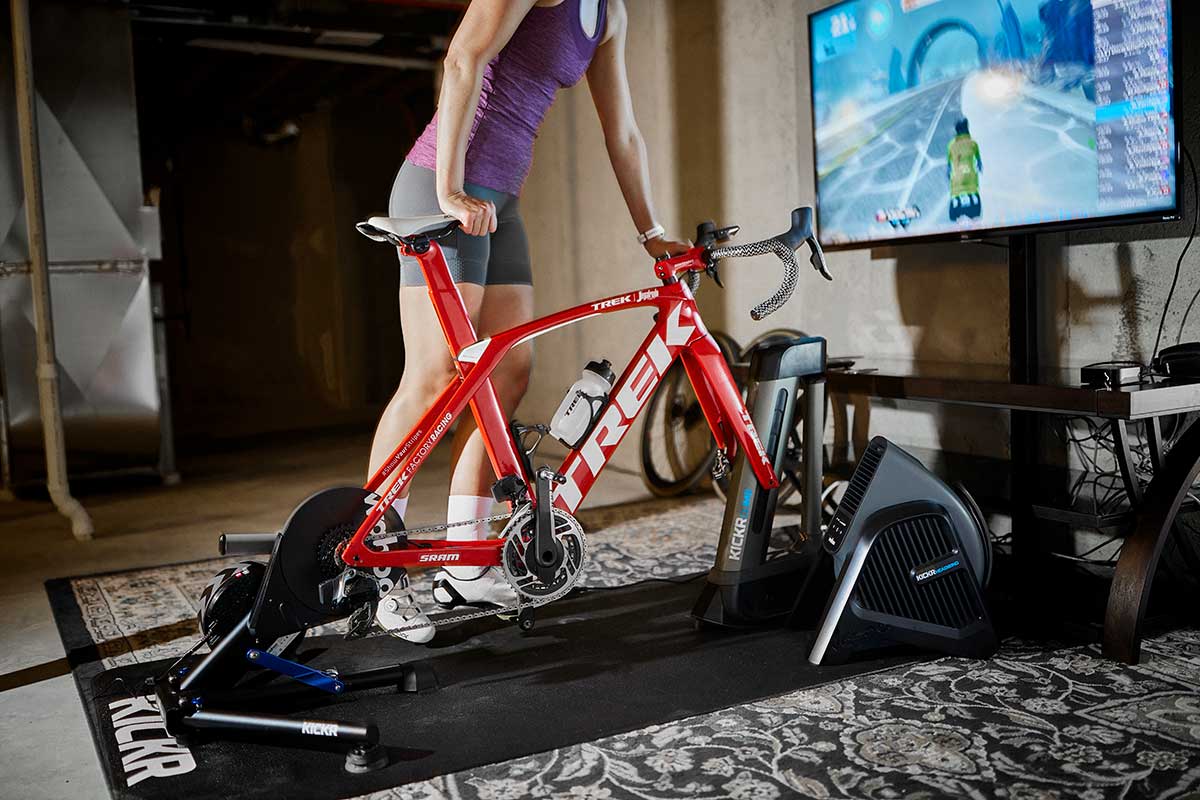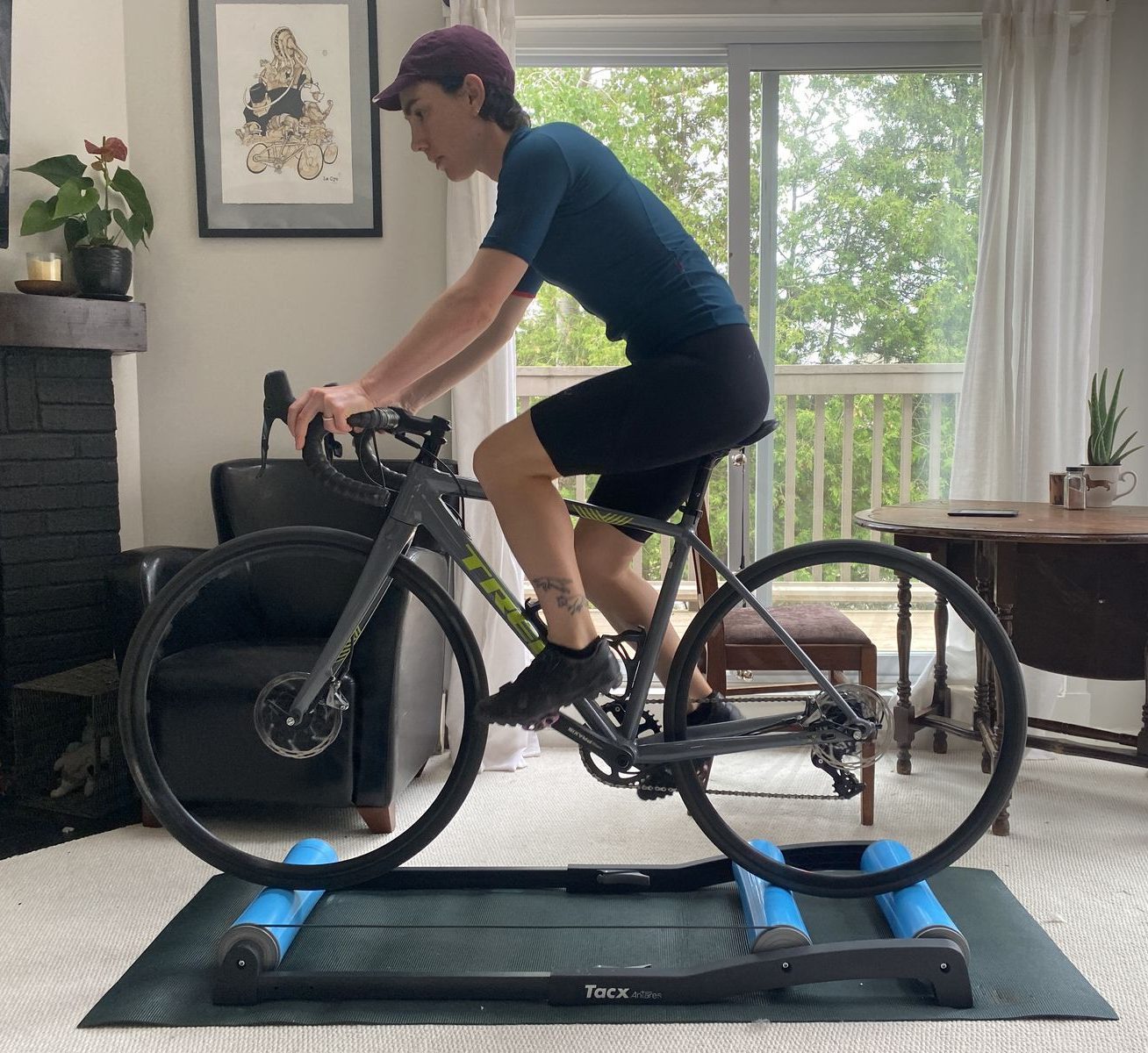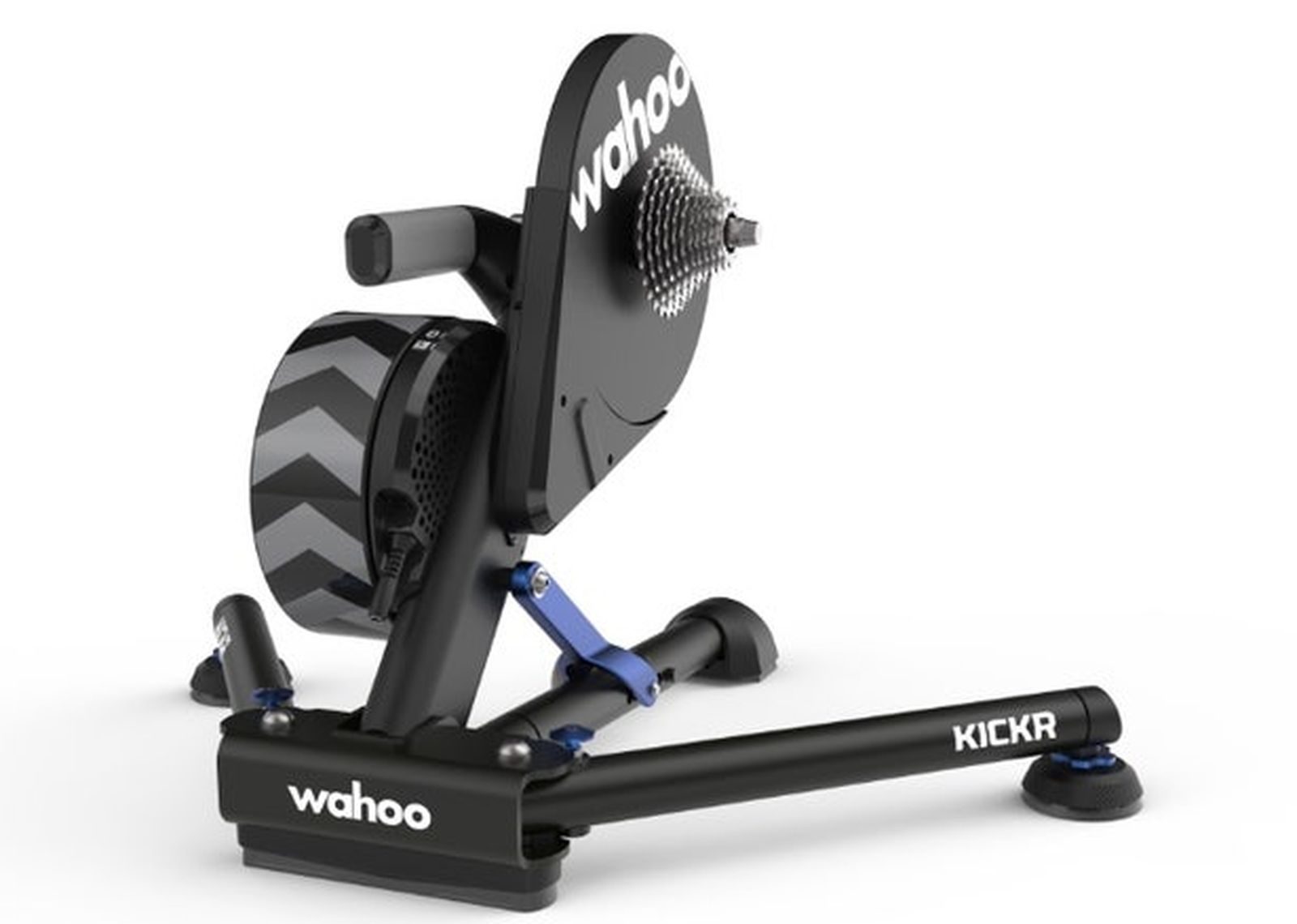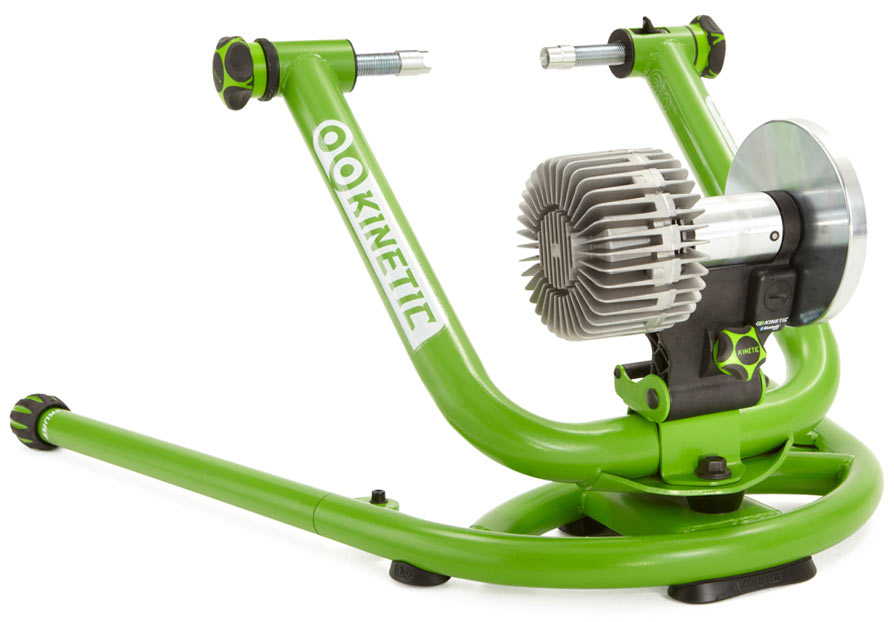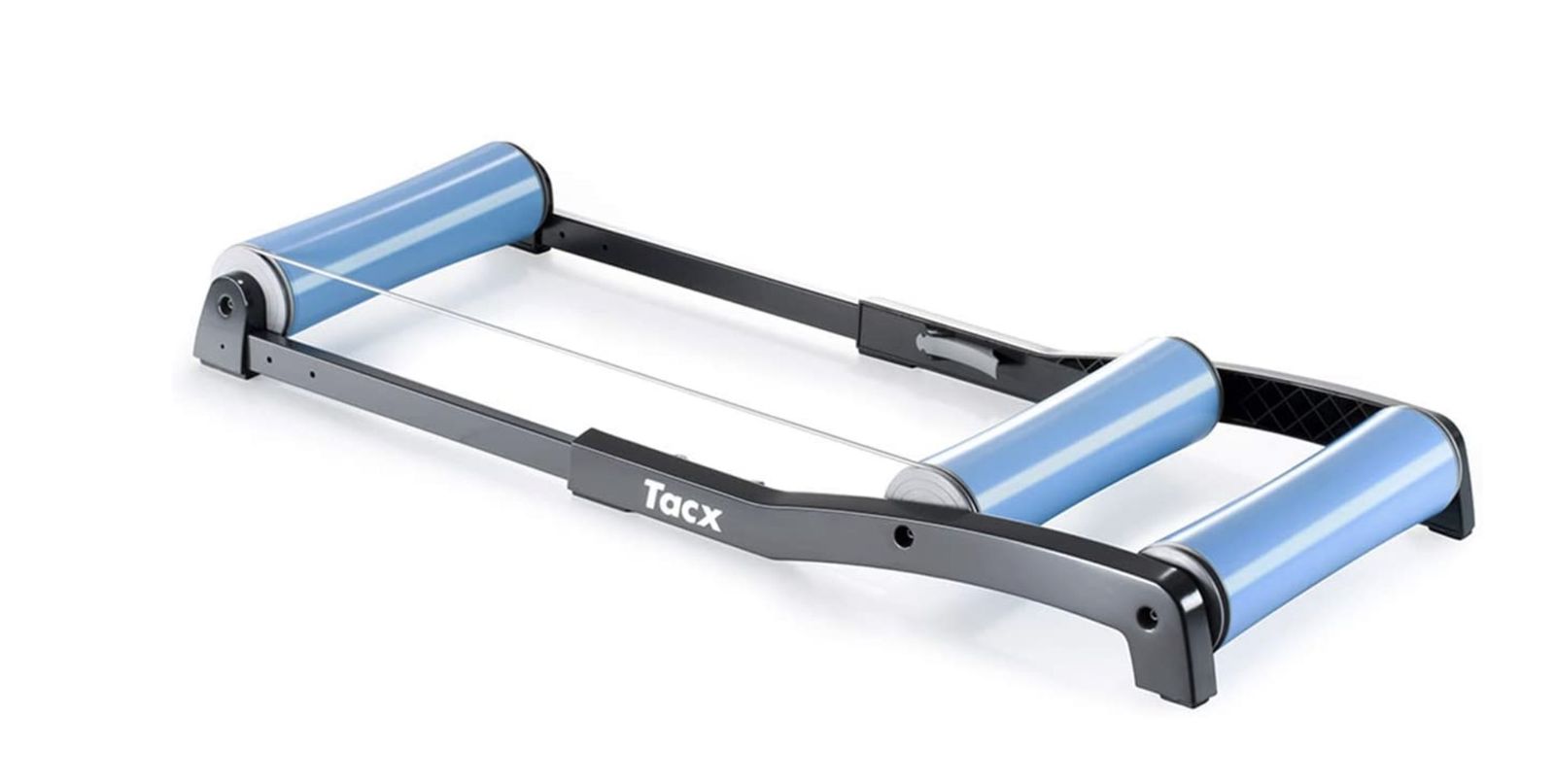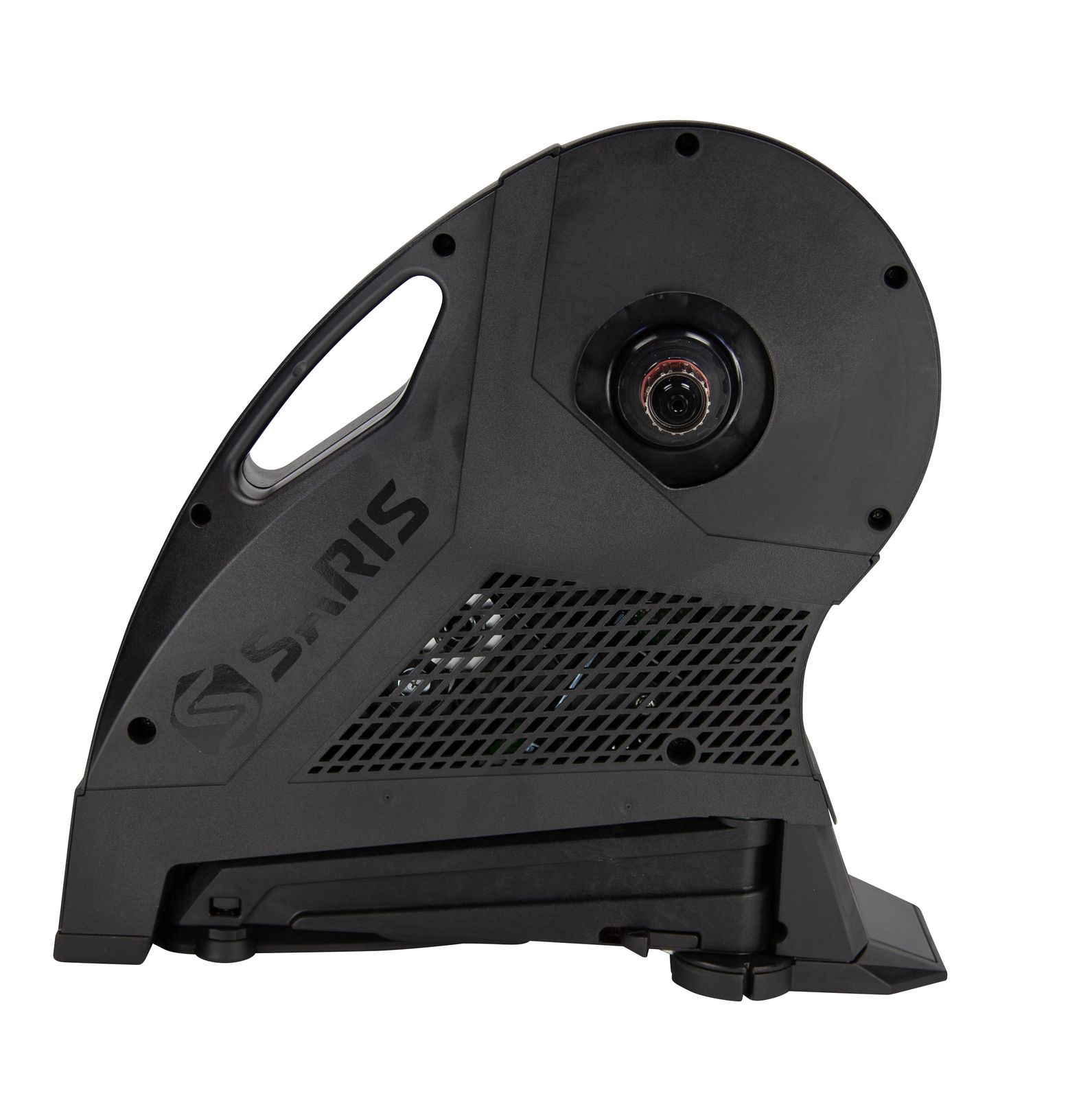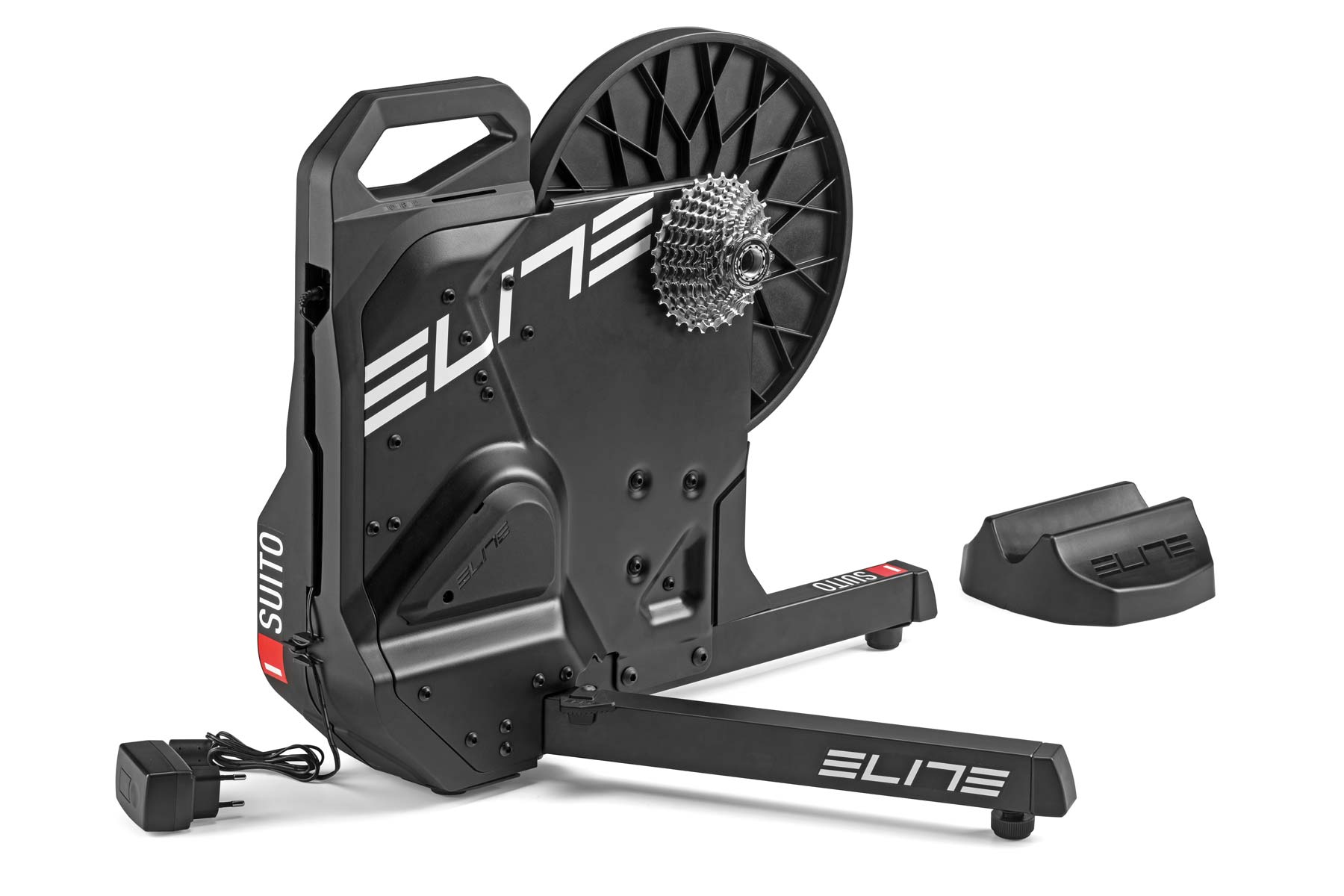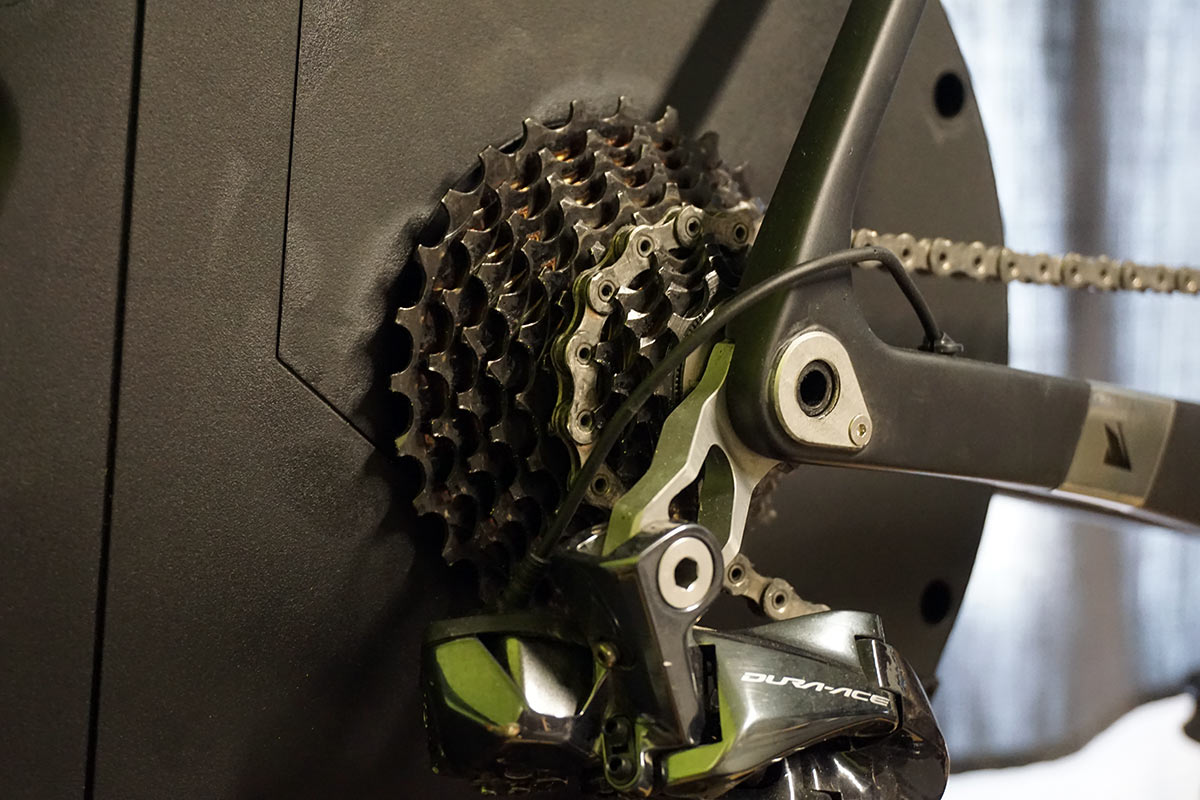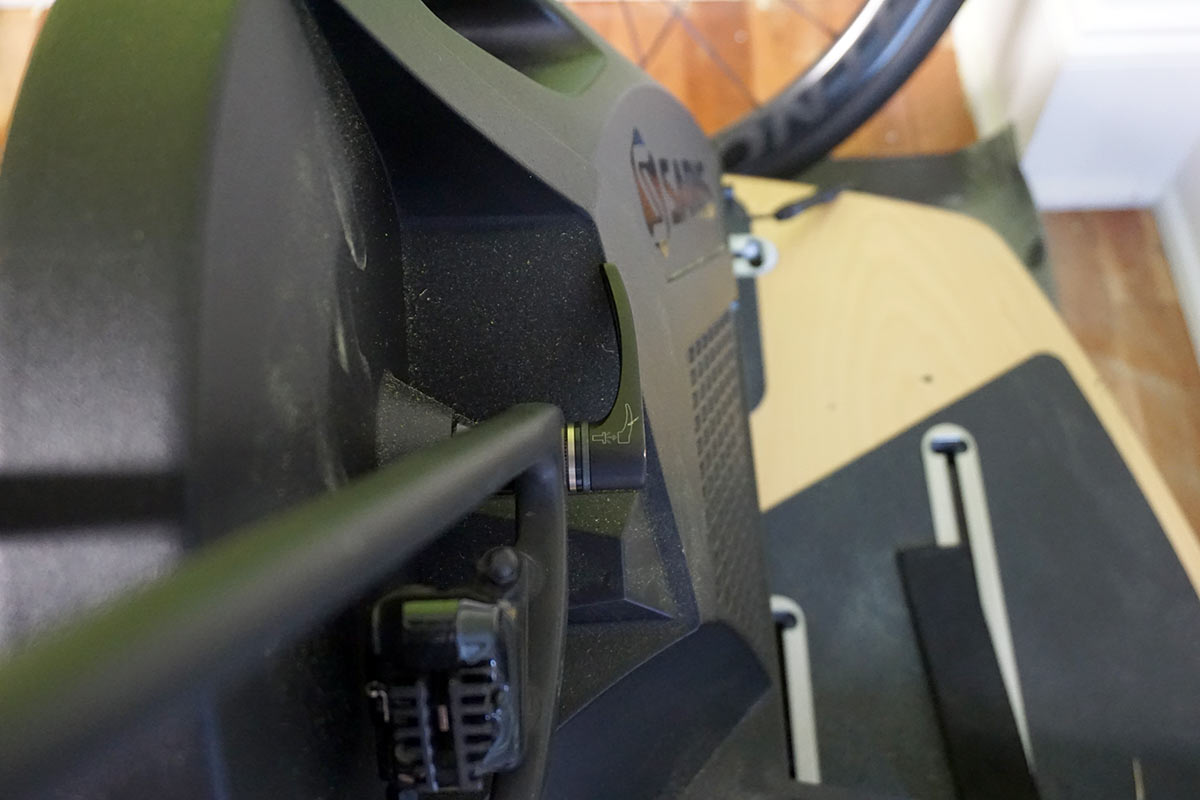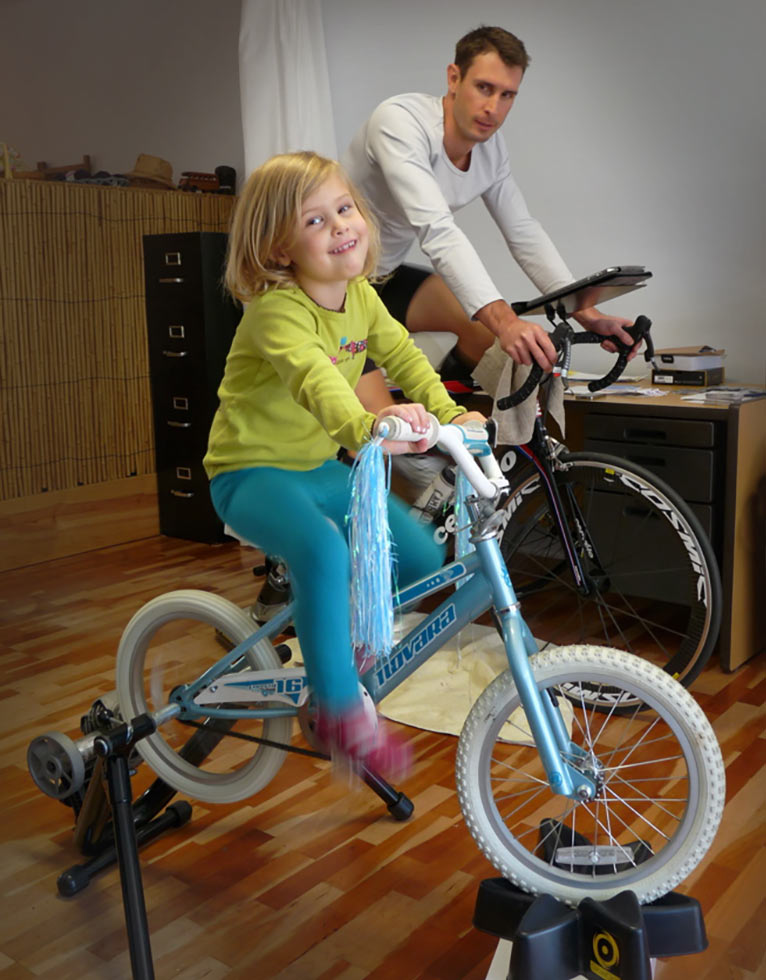Choosing an indoor trainer for riding inside can be tricky. There’s a huge range of products in a wide range of prices, from $70 to $1,500. And unless you’re already riding indoors a lot, it can be hard to know which features you really need.
Maybe you’ve heard about racing on the online platform Zwift and you like the idea of riding in groups even when you’re stuck inside. Or maybe you’re just trying to get into the habit of pedaling and need a simple setup that won’t break the bank.
If you’re new to cycling, an indoor bike trainer (aka stationary bike trainer) refers to a device that you hook your bike into—either with or without the rear wheel, depending on the model—allowing you to turn your existing bicycle into an indoor stationary bike. It’s a great solution for easy indoor training, and the technology has become so advanced that a stationary trainer can even help you race virtually with other cyclists from around the world!
Here, we’re looking at the different types of indoor trainers and sharing our favorites from years of testing, sweating, and racing…
What kinds of indoor cycling trainers are available?
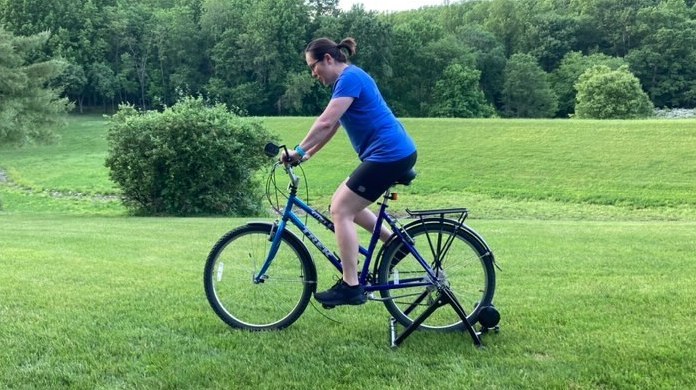
Magnetic & Fluid Trainers
Typically the cheapest trainers of the bunch, both magnetic and fluid indoor bike trainers allow you to pop your bike on—no assembly (or disassembly) required—and start pedaling. For most casual riders, one of these trainers will be enough to get you started, though they will require that you use a slick tire (that will end up wearing out pretty quickly if you ride a lot).
Magnetic trainers use (you guessed it) magnets to create resistance against a metal flywheel, while fluid (aka hydraulic) trainers use fluid to create resistance. The key difference is that a magnetic trainer will require some sort of manual adjustment to change the resistance, whereas fluid trainers get harder the faster and harder you pedal, thus offering a more realistic road feel.
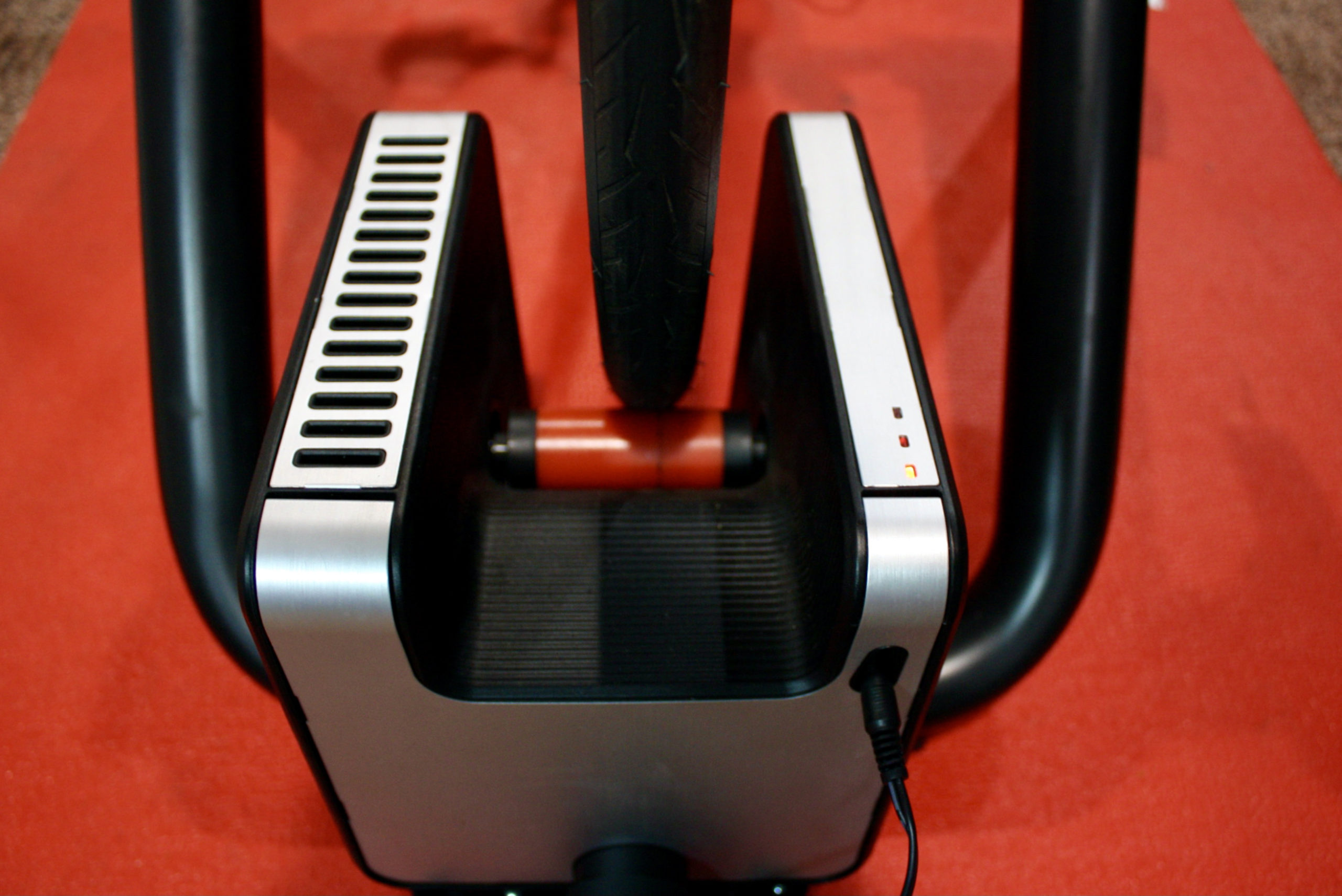
Also called “wheel on” trainers (because you leave the rear wheel on the bike), higher-end models will have larger, heavier flywheels attached to them to improve the “road feel” and smooth out their response to changing speeds.
If you have a newer bike with a thru-axle connecting your rear wheel to the frame, you may need to buy a new rear skewer that will be compatible with your trainer. Even so, they’re the cheapest option.
Direct Drive Trainers
Direct-drive trainers are great for off-road riders because your rear wheel is removed from the equation, making it just as easy to mount a mountain bike as a road bike. That means your tires won’t get worn out, and you won’t have to swap your knobby tire for a slick one to get a smooth pedaling experience.
Direct drive also tends to feel more natural, like you’re riding on the road, compared to the potentially “sticky” feeling of magnetic or hydraulic trainers. Direct-drive trainers are more expensive, though, and most are even pricier because they’re ‘smart trainers.’ They also require a cassette that works with your derailleur: Many come stock with 11-speed cassettes, so if you have a 10-, 12- or 13-speed, you’ll need to swap out the trainer cassette.
Smart Trainers
Smart trainers use Bluetooth, ANT+, or WiFi to pair with an app and dial in your training—and yes, they typically need to be plugged into an outlet. Need to push 220 watts for 17 minutes? Just enter that in, and your trainer will keep you pedaling at that wattage no matter how tough it gets.
Smart trainers are also the easiest, but not the only, way to get connected to virtual racing. If your bike has a power meter that’s ANT+ or Bluetooth-compatible, you can use a ‘dumb trainer’ and still connect to apps like Zwift. (Smart trainers can be direct drive, magnetic or fluid, though most tend to be direct drive.)
Rollers
If you’re hoping to improve your balancing skills or to improve your pedal stroke, rollers are your best bet. They can be a little intimidating and tough to get started on, but once you learn how to get started and stopped, they can be a lot of fun and a great way to stay incredibly focused during your workout. These can also be connected to Zwift or other virtual platforms if you already have ANT+ or Bluetooth-compatible power on your bike.
The Best Indoor Bike Trainers
BEST OVERALL: Wahoo KICKR
The Wahoo KICKR Smart Trainer is one of the most durable and easy-to-use trainers on the market—and arguably has the easiest-to-use apps that help you plan your workout or sync to your virtual racing platform of choice. Programming it is quick and easy, and the ride itself feels as close to riding outside as a trainer can get, thanks to the smooth direct drive that lets you snap your bike onto the trainer sans rear wheel and get to pedaling. It’s fairly quiet compared to other trainers available—especially non-direct drive ones—and we’ve never had any issues with dropped connections between the app or a virtual platform and the trainer.
While it’s not the cheapest smart trainer on the market, it’s actually fairly reasonable compared to some models out there. And while you don’t have to use this one to take advantage of Wahoo’s full array of training accessories, it will perfectly match their indoor climbing simulator, a smart fan that adjusts its speed to match your effort, and a desk that can hold your laptop, phone and bottle while you spin.
Grab their AXIS feet to add a slight rocking movement. It also comes with an 11-speed cassette and features thru-axle compatibility, making it one of the easiest trainers to use if you switch between bikes regularly.
The only downside is that this trainer isn’t lightweight—it’s 47 pounds—making setup a bit more difficult than some of the lighter options available. The heavier weight does make it feel more stable, especially for bigger riders, so it’s not necessarily a negative.
- Cassette: 11-speed included
- Axle Compatibility: Thru-axle compatible for rear hub widths of 142 mm or 148 mm, other models require an adapter
- Weight: 47 pounds
- Dimensions (open): 51” x 71” x 44”
- Included accessories: Trainer, Drive Side Adapter for 142 or 148 Thru Axle, Quick Release Skewer, AXIS Stiff, and Easy Feet
- Price: $1,300
PROS: Easy to set up and use, works with most bikes
CONS: Heavy, more expensive than less feature-rich options
BEST BUDGET SMART TRAINER: Kinetic by Kurt Smart Bike Trainer
Bikerumor staffers really enjoy the more engaged feel of the Kinetic Smart Trainer—whether riding the smart or even the older “dumb” version of this fluid trainer. It’s a great middle-ground for someone who’s newer to cycling and is on a tight budget, but still wants a smooth ride and the ability to race virtually.
The Rock and Roll trainer uses fluid resistance to progressively make the ride harder or easier. But its key feature that earns its spot here is the “Rock and Roll” side-to-side motion that creates a very realistic ‘riding outside’ feeling. It’s a great option for someone who doesn’t like riding on a trainer, but knows they need to and doesn’t want to spend a fortune to do it.
The trainer’s smart features come from a pre-installed inRide 3 power sensor that allows you to sync with all the common virtual racing platforms including Zwift, TrainerRoad, and Sufferfest. The Kinetic app (iOS/Android) lets you program your ride if you’re not into virtual racing. It also features ANT+ compatibility so you can use your cycling computer while you ride.
Plenty of available accessories increase compatibility options, and a dedicated trainer tire ($35) is designed for quiet, long-lasting trainer riding. If you have an old Kinetic trainer, the inRide 3 power sensor is sold separately to turn your old dumb trainer into a smart trainer. If you end up loving the experience, add their Kinetic Power Unit ($349) to add smart electronic resistance control for improved virtual training!
- Cassette: N/A
- Axle Compatibility: Quick release is standard; thru axles require a Kinetic Traxle adapter
- Weight: 29.4 pounds
- Dimensions (open): 27” x 27” x 11”
- Included accessories: Trainer, quick-release skewer
- Price: $370
PROS: Inexpensive, easy to set up, realistic rocking motion
CONS: Bulky, takes up a lot of space, can’t automatically adjust the resistance
BEST BUDGET: Veltuno Magnetic Bike Trainer
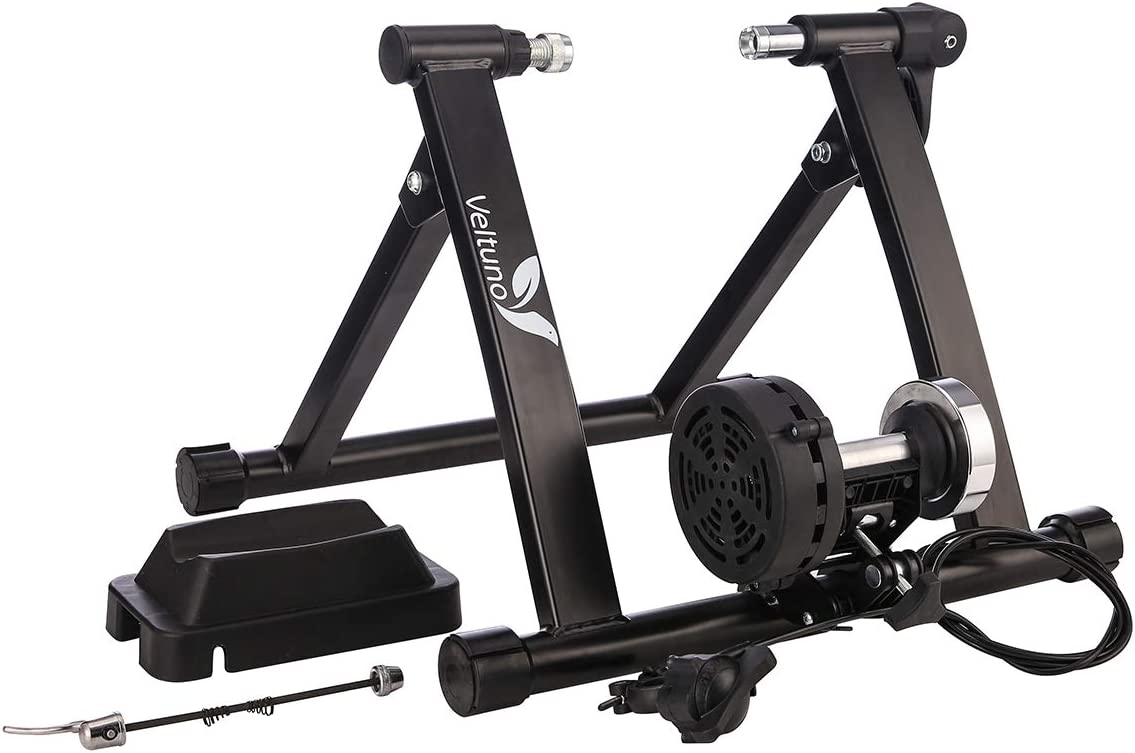
Is it fancy? Absolutely not. But will it get the job done? Yes—as long as you understand the limitations and aren’t expecting perfection. This steel trainer uses magnets to provide resistance and can be adjusted by hand from the back or with the wired dial that can be clipped to your handlebars to add or subtract resistance during your ride—choose from six settings. The trainer folds neatly up so when you’re done, it can stash in your closet and takes up significantly less space than the bulkier direct drive trainers.
If you’re a newer cyclist just looking to keep a bit of fitness in the offseason, this trainer is a budget-friendly place to start—this editor has recommended it to new riders and found that it’s worked perfectly for those who are just getting started and don’t have a lot of extra cash to spend. At $70, you can get it and try indoor riding for a season before committing to a pricier model, then pass it along to another new cyclist.
It’s louder compared to direct drive trainers like the Wahoo KICKR, but if you opt for a smooth, trainer-specific tire, you’ll cut down on the noise considerably. Setup is easy, and the beauty of this trainer is in its simplicity: There isn’t much to it, so it doesn’t have much that can go wrong.
While the trainer is rated up to 330 pounds, bigger riders may find that it starts rocking for standing sprints or hard efforts, so if you’re a burlier cyclist hoping to crank out massive wattages, this trainer will not be sturdy enough for you.
- Cassette: N/A
- Axle Compatibility: Quick release, but can use a 3rd party thru-axle with adapter (we like the Robert Axle Project thru-axle adapter that’s made for trainers)
- Weight: 20 pounds
- Dimensions (open): 21″ x 21″ x8″
- Included accessories: Trainer, riser block, quick-release skewer
- Price: $70
PROS: Cheap, simple to use, lightweight
CONS: Comparatively noisy, will wear out tires, not compatible with 29″ MTB wheels or thru-axles
BEST ROLLERS: Garmin Tacx Antares Rollers
Learning to ride rollers can be a bit of a steep learning curve, but some riders love the more balance-focused aspect of riding them and find them more engaging than a standard trainer. The Tacx Antares are arguably the best rollers on the market: The rollers are slightly conical, with a smaller diameter in the middle, so that your tires will naturally gravitate towards the center of the trainer rather than tending to shift from side to side.
The rollers fold in half for relatively easy storage, though still not as small as a magnetic trainer would be. You can adjust the wheelbase to fit different-sized bikes, and the rollers to fit 26” to 29” wheel diameters. Because you’re not mounting your bike, your axles don’t matter and there’s no worry about the size of your cassette. You can spin on any tire, though it’s recommended that you use a smooth tire rather than a knobby one for less noise.
Want the ability to simply pedal without the pressure of staying upright, or have someone else in your house who wants to ride but doesn’t like dealing with rollers? You can get the Tacx Antares Front Wheel Stand to attach your front fork to the rollers’ frame, effectively turning the rollers into a stationary trainer.
The only real downsides are that there’s no added resistance other than your weight pressing into them -these are more about spinning and balance than full-sprint efforts- and you’ll need power and cadence sensors on your bike to use them with virtual/training apps.
- Cassette: N/A
- Axle Compatibility: N/A
- Weight: 18.7 pounds
- Dimensions (open): 53” x 18.5” x 5”
- Included accessories: None
- Price: $200
PROS: Inexpensive, improves balance, low maintenance
CONS: Harder to get started, takes up a lot of space, not much resistance
BEST FOR BIGGER RIDERS: Saris H3
Bikerumor’s biggest staffers swear by the Saris H3—Hammer 3—direct drive smart trainer when it comes to stability. Many trainers use wings or legs that fold out diagonally and can feel a bit unsteady when a larger rider is hammering on the pedals, but the Saris H3 has wings that hinge at the front and come out to either side to create a more stable T-shape. That stability comes with a price – It’s the heaviest on the list at 47 pounds (a carrying handle for easier movement, though).
The Saris H3 carries an impressive load: It’s built for riders up to 300 pounds, tops out at 2000 watts, and can simulate grades of up to 20 percent…with quick but smooth transitions between resistance changes. Like other smart trainers, it offers two modes, Erg and Simulation, and it produces accurate power data. Compared to past versions, the H3 is significantly quieter thanks to a belt upgrade that reduces the sound to a mere 20 percent of previous iterations.
The downside is that Saris’s app isn’t ideal for manual operation, especially compared to the ease of Wahoo’s app. But the H3 pairs easily with apps like Zwift and Sufferfest with no problems. Ultimately, it works great as long as you have a different training app controlling it.
Most bikes will fit on this trainer, but it is BYOC (bring your own cassette) so in addition to the sticker price of the trainer, you’ll need to buy a cassette for it, and potentially a different thru axle. So while it’s less expensive than the Wahoo KICKR, the necessary accessories can easily up the price so that they’re comparable.
- Cassette: Not included
- Axle Compatibility: QR; Thru-axle compatible for rear hub widths of 142 mm or 148 mm, other models require adapters
- Weight: 47 pounds
- Dimensions (open): 31” x 18.5” x 19.5”
- Included accessories: Front tire tray, rear disc brake spacer
- Price: $800
PROS: Great for bigger riders, quiet, tons of resistance, super smooth
CONS: The app isn’t great, the cassette is sold separately, DT Swiss thru-axles won’t fit well
BEST FOR SMALL SPACES: Elite Suito
If you live in a small space and need to break down your trainer setup after each spin, the Elite Suito might be the best smart trainer option for you. The legs fold into its already compact body, making it much smaller to store than any of the other trainers on this list. Its built-in handle and svelte 31-pound weight make it much easier to put away and pull back out for your next ride.
Despite those diminutive specs, we found that this trainer feels more secure and stable—even for bigger riders—than many of the other trainer options on the market, even when putting out big watts. The Elite Suito can handle up to 1900 watts, which is plenty for pretty much any rider. Its only mechanical flaw is that it’s not quite as quiet as the Wahoo KICKR… but it is quieter than any non-direct drive options. And while it syncs well to the common training apps that work with smart trainers, like Zwift, TrainerRoad, or Sufferfest, Elite’s own apps aren’t great.
Setup is simple, from putting the bike on to syncing with apps, and compared to the price of many smart direct drive trainers, this one is relatively inexpensive at $900, which includes an 11-speed Shimano cassette.
- Cassette: 11-speed Shimano 105 cassette
- Axle Compatibility: Quick release, but can use thru-axle with adapter
- Weight: 32 pounds
- Dimensions (open): 22″ x 29.9″ x 19.48″
- Included accessories: Trainer and cassette, riser block, thru-axle adapter (works with some models)
- Price: $800
PROS: Easy to store, sturdy, relatively inexpensive
CONS: The app isn’t great
How to Choose an Indoor Trainer
Before you pick a trainer off this list, you’ll want to consider a few things about your riding style:
Your bike type: Depending on what type of bike you currently have, you may be limited by the type of trainer that will work with it. A road bike with quick-release skewers will work on pretty much any trainer. Knobby-tired gravel, cyclocross, or mountain bikes will work on direct drive trainers, but if you want to use a magnetic or fluid trainer, you’ll need to swap for a slick rear tire. For rollers, you’ll need slick tires on the front and rear.
Direct drive trainers also need to have the right cassette on them, but that’s an easy adjustment to make…as long as your trainer brand offers the right freehub model (Like XD or XD-R for SRAM 12-speed cassettes, or Campagnolo freehubs).
If you have thru axles on your wheels, you’ll need an adapter for every trainer with the exception of rollers—but because thru axles are becoming more popular, many of the higher-end trainers now come with thru-axle conversion kits. Just note that some thru-axles, like the DT Swiss one with its fixed lever, might not clear the trainer’s body, so you’ll want to get a tooled or QR thru axle from Robert Axle Project to make life easy.
Your body type: Unfortunately, some of the cheaper, lighter trainers are simply not going to be sturdy enough for some bigger people, especially as a larger rider starts to drop the hammer. If you are a bigger cyclist, consider one of the heavier trainers on this list, like the Wahoo KICKR (their more budget-friendly KICKR Core is also great for bigger riders), or consider riding on the rollers, since they won’t be affected by weight.
That said, one Bikerumor writer’s 270-pound father has no issues pedaling away on his $150 magnetic trainer. Now, he’s not trying to put out massive wattages or do workouts, he’s just spinning at an endurance pace, but it’s worth mentioning that if you’re only planning to ride casually, a cheaper trainer could still work.
Why you want to train: This is a big question. If you’re a swimmer just looking for a way to do more training inside during the winter months, you might not care about how smooth a ride feels, and a cheap magnetic trainer will do the trick.
But if you’re a road rider or serious mountain bike racer, you may want a direct drive smart trainer that will have a more natural feel and allow you to hop into virtual races to stay sharp. If use a trainer to warm up at the MTB or cyclocross races, a trainer that doesn’t need to be plugged in or rollers is more portable because doesn’t require power for pre-race warmups.
How many people will use the trainer: Remember to consider the other riders’ bikes in your house if you have a spouse or kids who will also want a turn on the trainer! For some people who have a “Shimano family” where everyone runs the same 11-speed 105 cassettes, a direct drive trainer will be simple for bike swaps. Others may find that a simpler hydraulic or magnetic trainer option is easier to swap bikes.
You may also realize you’d rather ride at the same time as your spouse, which could mean getting two Kinetic Rock and Roll 2 smart trainers rather than one Wahoo KICKR for roughly the same price.
Frequently Asked Questions about Indoor Trainers
What is a “Turbo Trainer”?
This is simply a popular phrase used to describe indoor cycling trainers, but it refers to any normal indoor bike trainer. That said, the phrase “smart trainer” is all but replacing “turbo trainer” these days.
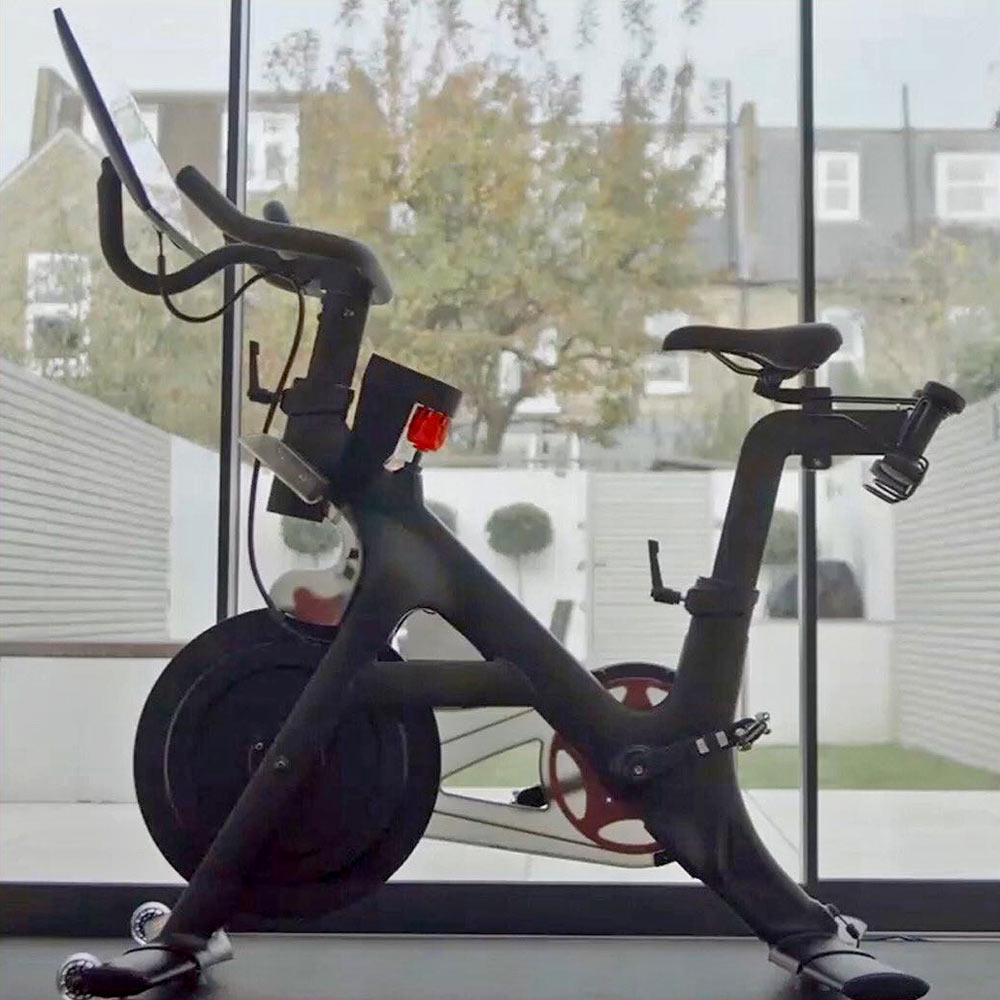
What’s the difference between a trainer and a stationary bike?
If you’re new to cycling or indoor training, you may be confused by terms like trainer versus stationary bike, fitness bike, etc. With an indoor bike trainer, you’re attaching your bike that you normally would ride outside. A stationary bike, on the other hand, is a purpose-built indoor bike that’s strictly for indoor use. (A stationary bike is what you’ll see in a spin class, or in the currently trendy Peloton ads.)
Do you need a direct drive?
If you want the smoothest, most natural-feeling ride, a direct drive trainer is the way to get it. It’s also a good long-term budget choice if you ride a lot. While it costs more up-front, you won’t need to regularly replace your rear tire like you would on a magnetic trainer that wears out the tread. And it’s a lot quieter, which keeps the peace around your house…and pets can’t accidentally walk into your spinning rear wheel!
Do you need a smart trainer?
If you have a power meter that uses ANT+ or Bluetooth on your bike already, you don’t need a smart trainer in order to take advantage of things like virtual racing. But if you don’t have a power meter on your bike already, or you want the ability to build workouts on an app that will keep you in the zones you’re aiming for by automatically adjusting the resistance, then a smart trainer is a good choice.
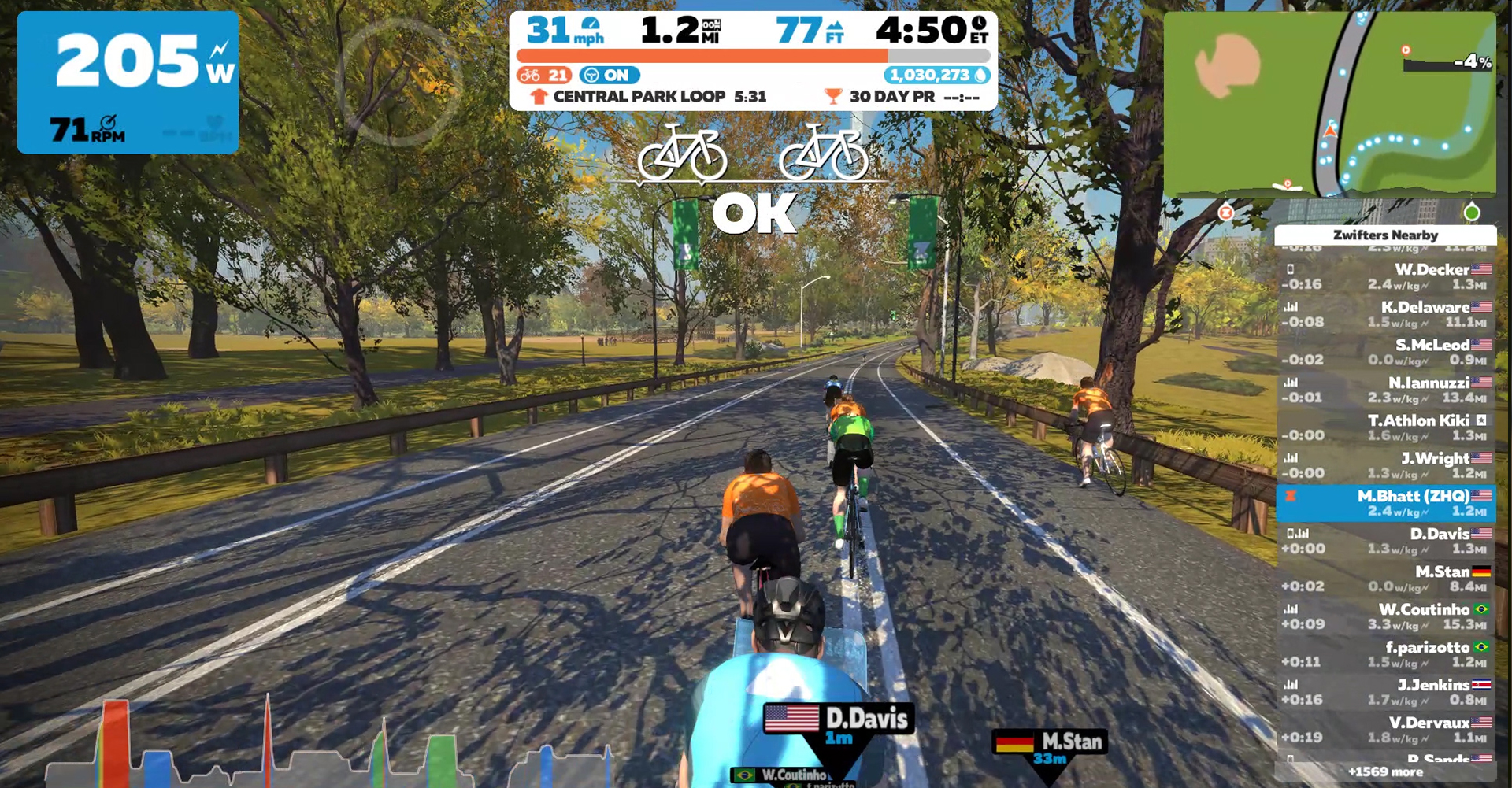
What modes do smart trainers run in?
Most smart trainers have two primary training modes: Simulation and Erg modes. Erg mode sets you at a specific power number and keeps you there, no matter how you shift or how slow or fast you pedal.
Simulation mode is similar to setting the resistance on a dumb trainer: It sets you to a specific “incline percentage,” but allows you to control your power by shifting or pedaling faster/slower. Simulation mode is typically what’s running as you pedal on Zwift, and will change with the terrain on whatever course you’ve chosen.

What is virtual racing?
Virtual racing uses power data—the watts you’re putting out while you pedal—to allow you to “race” against other cyclists on a virtual course. The course can sync to your smart trainer to create the feeling of hitting hills (adding more resistance) and even emulate pack riding (allowing you to sit in another rider’s virtual draft). It can be a great way to make an indoor ride feel more exciting, and there are thousands of options to choose from, from virtual no-drop group rides to all-out hammerfests.
Do I need a trainer that moves?
If you want your indoor ride to feel more dynamic, a trainer like the Kinetic Rock and Roll option that rocks from side to side as you pedal is a great option. Rollers will also allow your bike to move from side to side, but require a bit more balance to do so. Check out the Kinetic Rock and Roll trainer video above to see what that looks like.
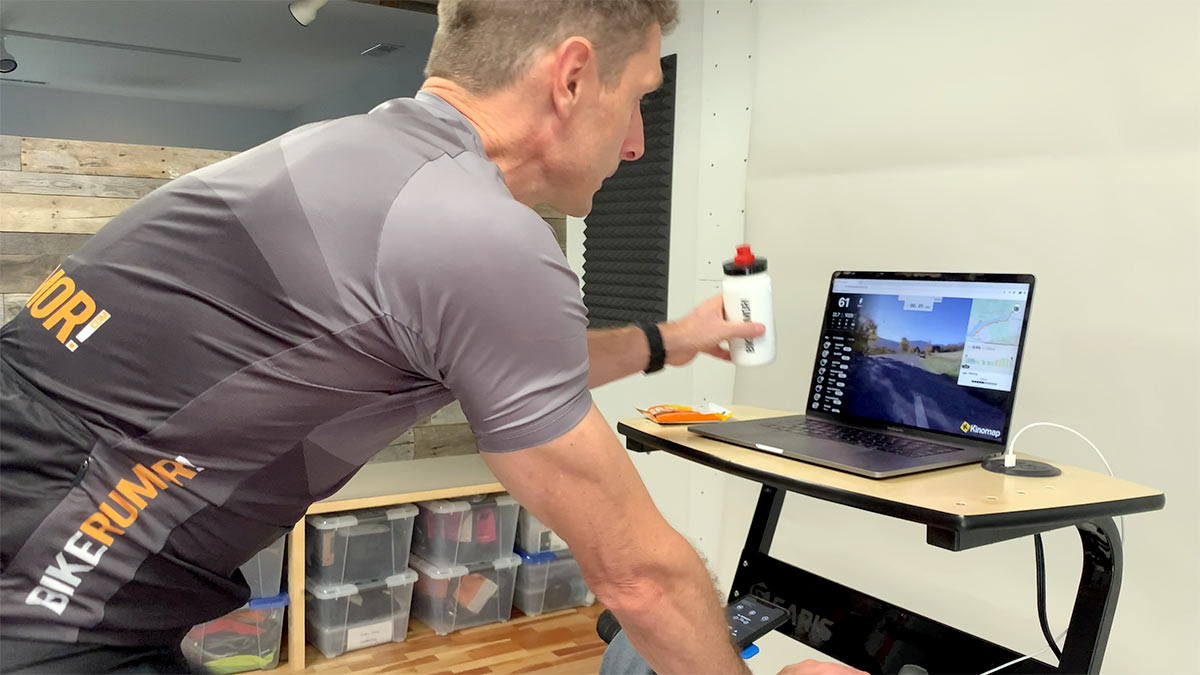
Do you need any trainer accessories?
You can ride a trainer without accessories (other than your bike, of course) but if you want to make the most of your ride, there are a few accessories that can improve your ride quality and comfort. We have a list of our favorite trainer accessories, from fans to desks to mats to cleaners (yes, you’re going to need to mop up that sweat somehow) that will make the experience much more pleasant.
And if you really get into it, we have a guide to creating the ultimate indoor cycling environment, from desks to big screens to floating platforms!
